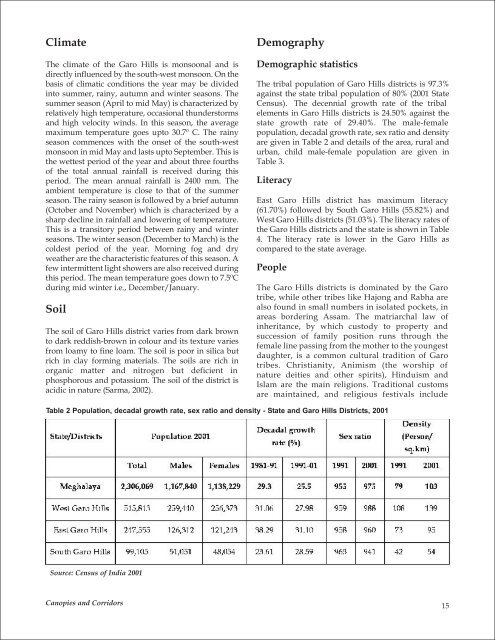Canopies and Corridors - International Fund for Animal Welfare
Canopies and Corridors - International Fund for Animal Welfare
Canopies and Corridors - International Fund for Animal Welfare
You also want an ePaper? Increase the reach of your titles
YUMPU automatically turns print PDFs into web optimized ePapers that Google loves.
Climate<br />
The climate of the Garo Hills is monsoonal <strong>and</strong> is<br />
directly influenced by the south-west monsoon. On the<br />
basis of climatic conditions the year may be divided<br />
into summer, rainy, autumn <strong>and</strong> winter seasons. The<br />
summer season (April to mid May) is characterized by<br />
relatively high temperature, occasional thunderstorms<br />
<strong>and</strong> high velocity winds. In this season, the average<br />
maximum temperature goes upto 30.7º C. The rainy<br />
season commences with the onset of the south-west<br />
monsoon in mid May <strong>and</strong> lasts upto September. This is<br />
the wettest period of the year <strong>and</strong> about three fourths<br />
of the total annual rainfall is received during this<br />
period. The mean annual rainfall is 2400 mm. The<br />
ambient temperature is close to that of the summer<br />
season. The rainy season is followed by a brief autumn<br />
(October <strong>and</strong> November) which is characterized by a<br />
sharp decline in rainfall <strong>and</strong> lowering of temperature.<br />
This is a transitory period between rainy <strong>and</strong> winter<br />
seasons. The winter season (December to March) is the<br />
coldest period of the year. Morning fog <strong>and</strong> dry<br />
weather are the characteristic features of this season. A<br />
few intermittent light showers are also received during<br />
this period. The mean temperature goes down to 7.5ºC<br />
during mid winter i.e., December/January.<br />
Soil<br />
The soil of Garo Hills district varies from dark brown<br />
to dark reddish-brown in colour <strong>and</strong> its texture varies<br />
from loamy to fine loam. The soil is poor in silica but<br />
rich in clay <strong>for</strong>ming materials. The soils are rich in<br />
organic matter <strong>and</strong> nitrogen but deficient in<br />
phosphorous <strong>and</strong> potassium. The soil of the district is<br />
acidic in nature (Sarma, 2002).<br />
<strong>Canopies</strong> <strong>and</strong> <strong>Corridors</strong><br />
Demography<br />
Demographic statistics<br />
The tribal population of Garo Hills districts is 97.3%<br />
against the state tribal population of 80% (2001 State<br />
Census). The decennial growth rate of the tribal<br />
elements in Garo Hills districts is 24.50% against the<br />
state growth rate of 29.40%. The male-female<br />
population, decadal growth rate, sex ratio <strong>and</strong> density<br />
are given in Table 2 <strong>and</strong> details of the area, rural <strong>and</strong><br />
urban, child male-female population are given in<br />
Table 3.<br />
Literacy<br />
East Garo Hills district has maximum literacy<br />
(61.70%) followed by South Garo Hills (55.82%) <strong>and</strong><br />
West Garo Hills districts (51.03%). The literacy rates of<br />
the Garo Hills districts <strong>and</strong> the state is shown in Table<br />
4. The literacy rate is lower in the Garo Hills as<br />
compared to the state average.<br />
People<br />
The Garo Hills districts is dominated by the Garo<br />
tribe, while other tribes like Hajong <strong>and</strong> Rabha are<br />
also found in small numbers in isolated pockets, in<br />
areas bordering Assam. The matriarchal law of<br />
inheritance, by which custody to property <strong>and</strong><br />
succession of family position runs through the<br />
female line passing from the mother to the youngest<br />
daughter, is a common cultural tradition of Garo<br />
tribes. Christianity, Animism (the worship of<br />
nature deities <strong>and</strong> other spirits), Hinduism <strong>and</strong><br />
Islam are the main religions. Traditional customs<br />
are maintained, <strong>and</strong> religious festivals include<br />
Table 2 Population, decadal growth rate, sex ratio <strong>and</strong> density - State <strong>and</strong> Garo Hills Districts, 2001<br />
Source: Census of India 2001<br />
15

















